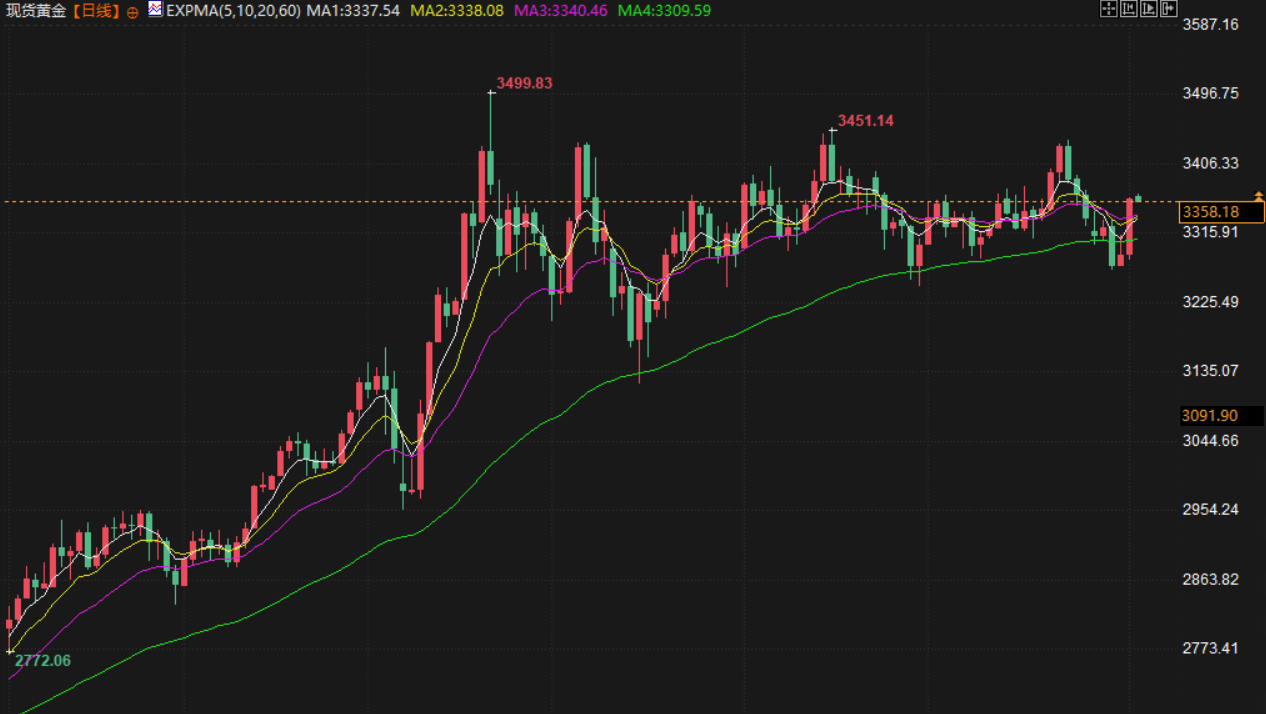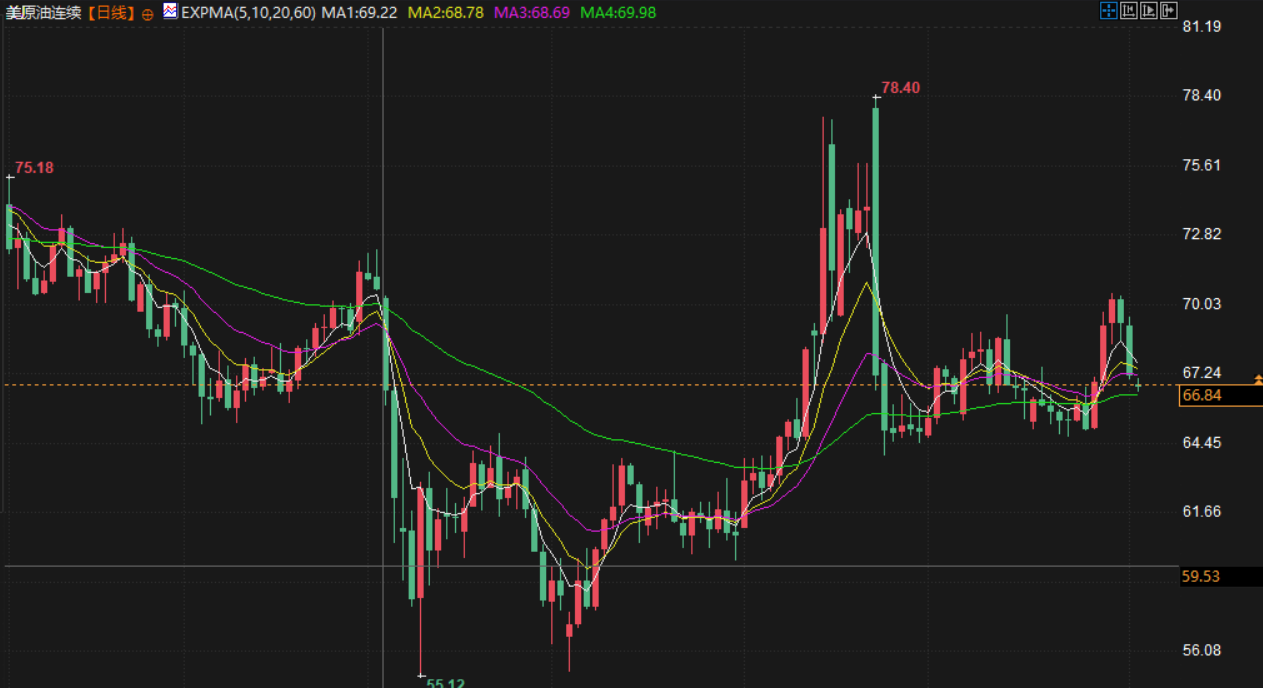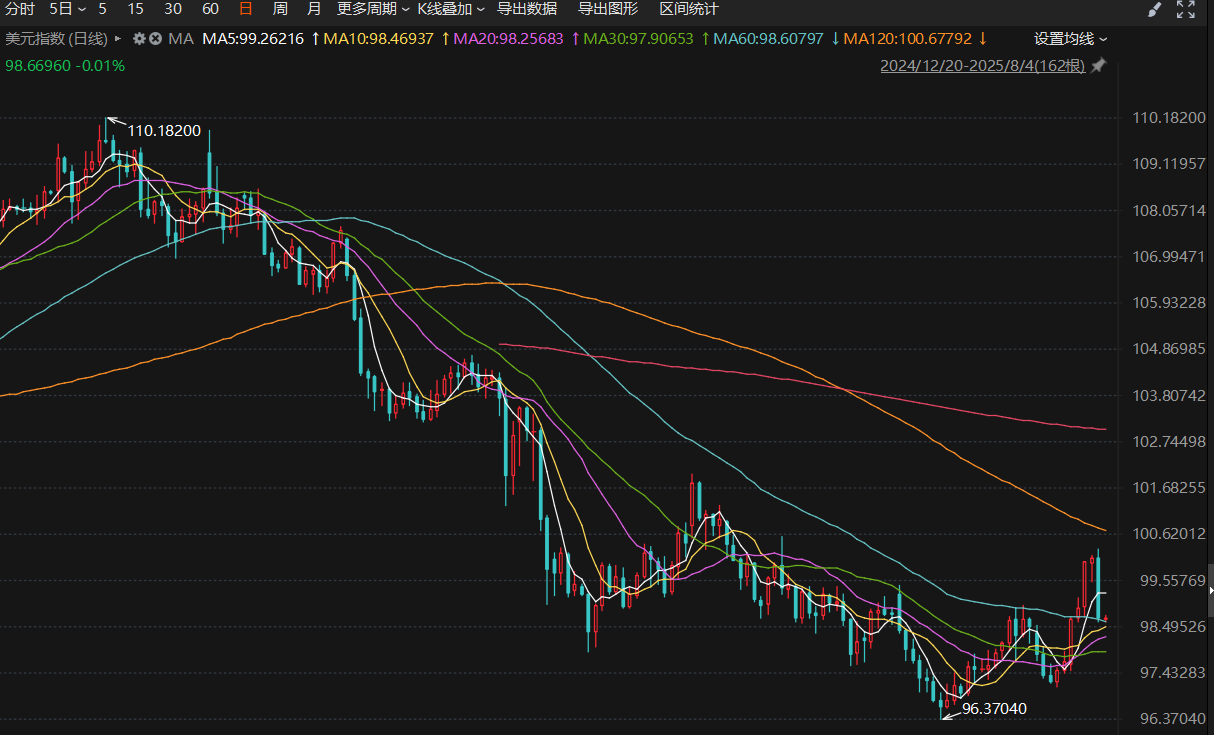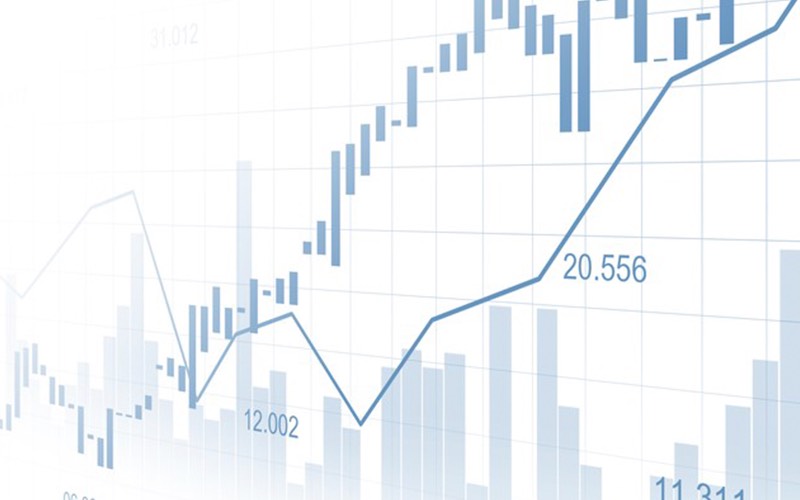August 4th Financial Breakfast: Non-farm payrolls surprise, gold hits a one-week high, OPEC+ reaches production increase agreement, and the global crude oil supply landscape shifts.
2025-08-04 07:23:32

Focus on the day

stock market
Wall Street tumbled on Friday, with the S&P 500 suffering its biggest one-day percentage drop in more than two months, as the United States slapped new tariffs on dozens of trading partners and an unexpectedly weak U.S. jobs report fueled selling pressure.
Amazon's 8.3 percent drop also weighed on the broader market after the company reported quarterly results for its Web Services cloud computing unit that fell short of lofty market expectations.
U.S. President Trump signed an executive order imposing tariffs on imports from Canada, Brazil, India and other places, as countries try to find ways to reach a better agreement.
Data showed U.S. job growth slowed more than expected in July and June's reading was revised sharply lower, suggesting cracks may be starting to appear in the labor market and further undermining confidence in the economic outlook. The report significantly strengthened expectations that the Federal Reserve will cut interest rates at its September meeting.
“There’s no way to sugarcoat this report,” said Brian Jacobsen, chief economist at Annex Wealth Management. “Prior months were revised down significantly, and the labor market has been stagnant. The Fed blew it last year by not cutting rates in July, so they made up for it with a catch-up cut at a subsequent meeting. They may have to do the same thing this year.”
According to CME's FedWatch tool, the market expects an 86.5% chance that the Federal Reserve will cut interest rates by at least 25 basis points at its September meeting, up from just 37.7% in the previous trading day.
The Dow Jones Industrial Average fell 1.23% to 43,588.58, the S&P 500 dropped 1.60% to 6,238.01, and the Nasdaq dropped 2.24% to 20,650.13.
The S&P 500 had its biggest one-day percentage drop since May 21, and the Nasdaq had its biggest one-day percentage drop since April 21.
Last week, the S&P 500 fell 2.36%, the Nasdaq fell 2.17%, and the Dow Jones Industrial Average fell 2.92%.
The CBOE Volatility Index, known as Wall Street's fear gauge, rose 3.66 points to 20.38, its highest close since June 20.
Amazon was the biggest drag on the Dow Jones Industrial Average, S&P 500 and Nasdaq, and caused the consumer discretionary sector to fall nearly 3.6%, the worst performance among the 11 major sectors.
Apple shares fell 2.5% after the company forecast quarterly revenue well above Wall Street expectations, but Chief Executive Tim Cook warned that U.S. tariffs would increase quarterly costs by $1.1 billion.
Following the jobs report, Trump said he had ordered the firing of Erika L. McEntarfer, director of the Bureau of Labor Statistics.
Gold Market
Gold prices rose nearly 2% on Friday to a one-week high as weaker-than-expected U.S. non-farm payrolls data boosted expectations of a Federal Reserve rate cut, while new tariff announcements stimulated safe-haven demand.

Spot gold rose 1.8% to $3,347.66 an ounce, having earlier risen 2% to its highest level since July 25. It rose 0.4% last week. U.S. gold futures settled 1.5% higher at $3,399.8. "The jobs data came in below expectations," said Bart Melek, head of commodity strategy at TD Securities. "This increases the likelihood of a Fed rate cut later this year." Gold, a non-yielding asset, tends to perform well in a low-interest rate environment. The U.S. Bureau of Labor Statistics said U.S. job growth slowed more than expected in July, with non-farm payrolls increasing by 73,000 jobs after a downwardly revised 14,000 gain in June.
Market participants currently expect the Fed to cut interest rates twice before the end of the year, with the first cut in September. Earlier this week, the Fed kept its benchmark interest rate target range unchanged at 4.25% to 4.50%, with Fed Chairman Powell stating that "we haven't made any decisions about September yet."
On trade, Trump imposed the latest round of tariffs on products from dozens of trading partners, including Canada, Brazil and India, sending global markets tumbling as countries scrambled to negotiate better deals.
Spot silver rose 0.4% to $36.88 an ounce, platinum gained 1.2% to $1,304.91 and palladium climbed 1.4% to $1,208.05. All three metals fell last week.
Oil Market
Oil prices plummeted by about $2 last Friday as investors worried about a potential OPEC+ production increase and a weaker-than-expected US jobs report heightened demand concerns. Brent crude futures settled at $69.67 per barrel, down 2.83%. U.S. crude futures settled at $67.33 per barrel, down 2.79%. Last week, Brent crude rose nearly 6%, while U.S. crude rose 6.29%.

The eight OPEC+ members are expected to approve on Sunday an oil output increase of as much as 548,000 barrels per day (bpd) in September, three sources said. Another person said discussions on the size of the increase were ongoing and the final hike could be smaller.
The U.S. Labor Department said the U.S. added 73,000 jobs in July, fewer than economists expected, and the unemployment rate rose to 4.2% from 4.1%.
The Fed's decision last Wednesday to keep interest rates unchanged drew criticism from Trump and a number of Republican lawmakers.
Oil traders spent much of last week focused on the potential impact of U.S. tariffs, which are set to take effect on most of its trading partners on Friday.
Trump signed an executive order last Thursday imposing immediate tariffs ranging from 10% to 41% on U.S. imports from dozens of countries and regions, including Canada and India, that failed to reach trade deals by an August 1 deadline.
"We believe that, with a few exceptions, the trade deal has been resolved more or less to the market's satisfaction, which has been the main driver of the bullish outlook for oil prices in recent days," said Suvro Sarkar of DBS Bank.
Oil prices were also supported last week by Trump's threat to impose 100% secondary tariffs on buyers of Russian crude to pressure Moscow to end its war in Ukraine, a move that sparked concerns about potential disruptions to oil trade flows and reduced supplies.
foreign exchange market
The dollar fell against the euro and yen on Friday, posting its biggest one-day drop since April, after data showed U.S. employers added fewer jobs in July than economists expected and June's job gains were revised sharply lower, leading traders to increase bets on how many times the Federal Reserve may cut interest rates this year.

Employers added 73,000 jobs last month, below the 110,000 jobs forecast by economists polled by Reuters, while the unemployment rate rose to 4.2% from 4.1% in June, in line with expectations. June's job creation was revised down to just 14,000 from the previously reported 147,000.
Helen Given, director of trading at Money USA in Washington, said the situation was worse than anyone expected, and the worst part was that the data for the previous month was also revised downward. The dollar index, which measures the greenback against a basket of currencies (including the yen and the euro), fell 1.06% to 98.97.
The euro rose 1.16% to $1.1547 against the dollar. Earlier on Friday, the euro fell to $1.1389, its lowest point since June 10.
The dollar fell 2.01% against the yen to 147.7 yen. The dollar earlier reached 150.91 yen, its highest since March 28.
The Federal Reserve said it is in no rush to cut interest rates due to concerns that President Trump's tariff policies will reignite inflation in the coming months.
Traders of federal funds futures reduced their bets on how many times the Fed might cut interest rates this year after Federal Reserve Chairman Jerome Powell struck a hawkish tone on the outlook for monetary policy on Wednesday and declined to say a rate cut in September was possible.
But they again increased their bets on rate cuts after Friday’s jobs data. Traders are now pricing in 58 basis points of rate cuts by the end of the year, up from about 34 basis points last Thursday, with the first cut expected in September.
"Whether the Fed cuts rates in September may now hinge on the next jobs report in August," Given said. "(Powell) did say on Wednesday that we're going to hold rates steady for a while longer, but we're going to get two sets of jobs data before the next Fed meeting. So, since the first set is clearly negative... the labor market is clearly cooling, that will also increase the importance of the September data."
August jobs data will be released on September 5, and the Federal Reserve will meet on September 16-17. A more dovish Fed could have a negative impact on the dollar, which appeared to have found its footing in recent weeks after a rocky first half of the year.
Jonas Goltermann, deputy chief market economist at Capital Economics, said: "Our forecast for a stronger dollar in the second half of the year relies heavily on our view that the US economy will remain resilient and that the FOMC will remain on hold until 2026. Clearly, this now looks less likely. In the event of a recession, the dollar would likely weaken against lower-yielding currencies such as the yen and euro, even if it could rebound against other riskier currencies."
The dollar briefly rallied early Friday after Trump imposed new tariffs on dozens of trading partners. The Swiss franc took the biggest hit, as Switzerland now faces a 39% rate.
The Swiss franc fell against several currencies in response to Trump's high tariffs and his demand that pharmaceutical companies, Switzerland's major exporters, lower prices for U.S. consumers.
The dollar fell 0.76% against the Swiss franc in late New York trading to 0.806, having earlier hit 0.8171, the highest since June 23.
The Canadian dollar rose 0.44% to C$1.38 against the U.S. dollar, having earlier retreated to C$1.3879, its weakest since May 22. Canada was subject to a 35% tariff, rather than the threatened 25%.
Besides tariffs, the dollar also gained against other currencies on other factors. The yen earlier posted its biggest weekly drop of the year after the Bank of Japan signaled it was in no rush to resume interest rate hikes, prompting Japanese Finance Minister Katsunobu Kato to say on Friday that Japanese authorities were concerned about recent exchange rate trends.
International News
Hot options trading drives Japanese exchanges to seek OTC strategy yield-enhancing ETF listings
Japan's major stock exchanges are seeking to capitalize on the growth of yield-enhancing strategies. Trading strategies such as covered calls (where investors sell call options while holding stocks to earn premiums) are becoming increasingly popular on the Tokyo Stock Exchange. To this end, the exchange is planning to allow the listing of actively managed ETFs that use over-the-counter derivatives. According to Kei Okazaki and Ryutaro Someya, heads of the Tokyo Stock Exchange's listing department, the exchange is seeking guidance from an advisory body to promote the listing of ETFs that use unlisted instruments such as swaps and options. Currently, while listed ETFs can use options on the Osaka Derivatives Exchange, the use of over-the-counter derivatives is prohibited. The Tokyo Stock Exchange hopes to obtain approval from the Financial Services Agency (FSA) to list such ETFs by June of next year. They note that this change will help reduce fund management costs.
Russia's Krasheninnikov volcano erupts for the first time in about 600 years
On August 3rd local time, the Krasheninnikov volcano in Russia erupted. This was the first eruption of the volcano in about 600 years. The Kamchatka branch of the Unified Geophysical Service of the Russian Academy of Sciences released a video of the volcanic eruption on the same day. This is the first time in modern history that scientists have observed the eruption of the volcano. The volcanic ash has now reached an altitude of 5,000 to 6,000 meters. The volcanic eruption is still ongoing and the eruption may affect low-altitude flights. The Krasheninnikov volcano belongs to the eastern volcanic belt of Kamchatka, located about 13 kilometers south of Lake Kronotsky and about 200 kilometers from Petropavlovsk-Kamchatsky. The last recorded magma eruption of the volcano occurred between 1423 and 1503. (CCTV News)
OPEC+ reached an agreement to increase production, changing the global crude oil supply pattern
The Organization of the Petroleum Exporting Countries and its allies (OPEC+) reached a consensus via videoconference on Sunday, agreeing to complete their one-year production recovery plan in September, significantly increasing crude oil production by 548,000 barrels per day (bpd). This move will fully offset the 2.2 million bpd production cuts implemented by eight OPEC members since 2023, with the UAE receiving an additional quota. Approximately 1.66 million bpd of idled capacity will be reassessed before the end of the year. This decision signals a strategic shift by OPEC and its allies from maintaining oil prices to competing for market share. Despite geopolitical tensions and strong seasonal demand, the production increase has effectively suppressed crude oil and gasoline futures prices, benefiting consumers and supporting US President Trump's energy policies. However, it has also raised market concerns about a global crude oil oversupply in the second half of the year. The production increase confirms the preliminary agreement previously reported by Bloomberg. Notably, the OPEC+ decision comes as the Trump administration is increasing pressure on Russia, threatening secondary sanctions on countries purchasing Rosneft unless the Russia-Ukraine conflict ends quickly. This diplomatic pressure forms a delicate interaction with Trump's demand for lower oil prices, as he also hopes the Federal Reserve will cut interest rates. It is worth noting that Russian Deputy Prime Minister Novak made a rare visit to Saudi Arabia on Thursday to discuss bilateral cooperation with the Saudi Energy Minister. As the dominant force in the OPEC+ alliance for nearly a decade, the interaction between the two countries will continue to influence the global energy market landscape.
Russian Federation Council member: The world cannot replace Russia's oil supply
Alexey Pushkov, a member of the Constitutional Committee of the Russian Federation Council, stated that the world cannot replace the amount of oil supplied by Russia, which accounts for about 10% of the global oil supply. Pushkov wrote on his social media platform: "Despite Trump's warning of high secondary sanctions tariffs, Indian refineries continue to purchase Russian oil. The Indian side explained that if the global market stops accepting 9.5 million barrels of oil per day from Russia, oil prices may rise to $135-140 per barrel. In fact, such a large amount of oil supply cannot be replaced at all, as Russia accounts for about 10% of the global oil supply." (Russian Satellite Network)
South Korea plans to cancel tax refund policy for foreign tourists for medical beauty treatments
South Korea's medical aesthetics have always been popular with foreign tourists, with many procedures offering a 10% VAT refund. However, the South Korean government recently decided to eliminate this tax refund policy starting next year. Reporters learned that this tax refund policy was implemented in April 2016 to boost tourism and attract foreign tourists to South Korea for medical aesthetics. Originally intended for one year, it has since been extended several times. Industry insiders in South Korea worry that the cancellation of the tax refund could lead to a decrease in tourists visiting South Korea for medical aesthetics and could also prompt some medical institutions to resort to cash transactions with their customers, creating a gray area. (CCTV.com)
Yale University's latest study: US consumers face the highest tariff rates since 1934
The latest research data from the Yale Budget Lab indicates that as of July 31, the average effective tariff rate imposed by the United States on imported goods reached 18.3%, the highest level since 1934. The average effective tariff rate is not a fixed value but is subject to change based on national policies, economic conditions, and the international trade environment. The Budget Lab predicts that the tariff policy will reduce US real GDP growth by 0.5 percentage points annually in 2025 and 2026. Furthermore, the tariffs will increase the US unemployment rate by 0.3 percentage points by the end of 2025 and by 0.7 percentage points by the end of 2026. Furthermore, the tariffs will increase the average US household expenditure by $2,400 in 2025, with a particularly severe impact on apparel. In the short term, consumers may see a 40% price increase for shoes and a 38% price increase for apparel. In the long term, footwear prices could rise by 19% and apparel prices by 17%. (CCTV News)
Domestic News
Ton-class unmanned aerial vehicle completes offshore platform material transportation for the first time
On August 3rd, reporters learned from China National Offshore Oil Corporation that my country's independently developed electric vertical take-off and landing aircraft, weighing over a ton, had completed its first cargo transport flight to an offshore oil platform. This breakthrough not only innovates the maritime supply model but also marks a key step forward in my country's application of low-altitude logistics in land and sea scenarios. The "Kairuiou," a two-ton electric vertical take-off and landing aircraft independently developed by my country, took off from a land-based landing point in Shenzhen, carrying supplies such as fresh fruit and emergency medicines. After a 58-minute cross-sea flight, it landed on an offshore oil and gas platform 150 kilometers from the Shenzhen coastline, successfully completing its transport mission. (CCTV News)
my country becomes the world's largest cosmetics consumer market
Since the beginning of this year, the cosmetics and fragrance industries, exemplified by the "Chinese aesthetic," have been accelerating their expansion into overseas markets. Data shows that in the first quarter of 2025, my country's cosmetics exports reached $1.69 billion, a year-on-year increase of 14.1%. In the first half of this year, my country's total cosmetics retail sales reached 229.1 billion yuan, a five-year high. Meanwhile, the market size of my country's cosmetics industry has exceeded one trillion yuan for two consecutive years, making it the world's largest cosmetics consumer market. Notably, last year, domestic brands accounted for 55.2% of transaction volume, surpassing international brands for the first time. (CCTV Finance)
- Risk Warning and Disclaimer
- The market involves risk, and trading may not be suitable for all investors. This article is for reference only and does not constitute personal investment advice, nor does it take into account certain users’ specific investment objectives, financial situation, or other needs. Any investment decisions made based on this information are at your own risk.





















